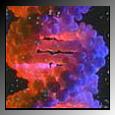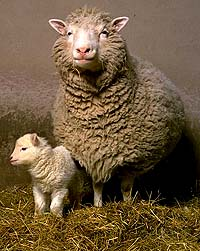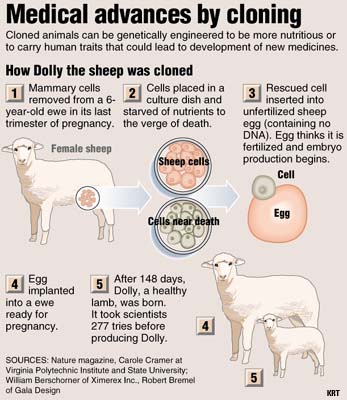


Dolly Videos Quotes Concerning Cloning Factsheet on Cloning The Ethics of Cloning
Related Topics

About Dolly
Dolly, a Finn Dorset sheep, was born on July 5th, 1996, at the Roslin Institute in Edinburgh, Scotland. Her birth, not revealed to the public until February 3rd, 1997, sparked controversy instantly, because Dolly was the world's first mammal to be cloned from an adult cell. Considered one of the most significant scientific breakthroughs ever, Dolly's birth and subsequent survival proved that adult cells can reprogram themselves into a new being. The team that created her, led by Scotsman Ian Wilmut, hoped to create an animal whose cells were genetically young again, rather than prematurely adult; however, when Dolly was reported to have been euthanased on February 14th, 2003, nearly six years after her birth, concern was raised that her progressive lung disease was caused because her cells were already old; she also had premature arthritis. Sheep can normally live to 11 or 12 years of age, and lung disease is not common in younger sheep. There was some speculation as to whether she caught it or not from the other sheep that she was housed with, but that claim has been neither confirmed nor denied.
Dolly, named
after singer Dolly Parton, bred normally on two occasions, with a
Welsh mountain ram named David, and over the course of her life
gave birth to four lambs; proving thus that clones can
reproduce.
Francis Crick and James Watson are widely recognized as some of the first pioneers in cloning technology. Their discovery of the double-helix structure of DNA in 1953, and later, their work on moecular heredity, helped to propel the science of biotechnology into the public view. This in turn led to an increase in scientific research that focused on learning the intricacies of the human genetic code and, subsequently, the discovery that cloning is possible and within reach of scientists today. Cloning as it exists today would probably not exist but for the research of these two men, who in 1962 received a Nobel prize for their work.
Another
important name in cloning
history is John Gurdon, who in 1962
announced that he had used the nucleus of fully
differentiated adult intestinal cells to clone South African
frogs. Gurdon’s experiment was widely talked about,
although it was never proven that the frogs were true clones.
In 1984, Steen Willadsun cloned a sheep from embryo cells, which were the predecessor to Dolly’s method of cloning. His work was the first verified incidence of cloning using nuclear transfer, which was remarkable at the time considering that only a few months earlier it had been said that it was biologically impossible.
The major debate over Dolly was the issue of subsequent human cloning. The ethics that need to be considered over this issue are enormous, and there is no one right answer. Since Dolly, human cloning advocates have lobbied to legalize cloning; but so far this has not happened. Some people are of the opinion that cloning is essentially "playing God" and is abominable to say the least; they cite cloning experiments that have gone awry, with such results as deformed fetuses with oversized organs, and birthed animals that were twice the normal size and died soon after. Overall, the Dolly debate still continues internationally, and has never really died away. Whatever the future of cloning may be, Dolly existed, and that in itself is a momentous event in human history.
Back to top of page
Timeline
Developments in cloning
| 1901 |
German scientist Hans Spemann
split a 2-cell newt embryo into two parts, successfully producing
two larvae. |
| 1938 |
Cloning was envisioned by Hans
Spemann--he theorized that animals could be cloned by fusing one
embryo with an egg cell. |
| 1952 |
Two American scientists, Robert
Briggs and T. J. King, attempt to replace frog egg nuclei with
adult frog nuclei. It did not develop. |
| 1953 |
Watson and Crick discover the
double helix stucture of DNA. |
| 1962 |
British molecular biologist John
B. Gurdon announced he had cloned frogs using the nuclei of fully
differentiated adult intestinal cells. |
| 1963 |
J.B.S. Haldane coined the term
"clone", which is derived from the Greek word klwn, meaning
"twig". |
| 1970 |
Gurdon tries same procedure
again. The tadpoles developed but died early; the transplanted
nuclei had reverted to an embryonic state. |
| 1977 |
German developmental biologist Karl Illmensee claim to create mice with a only a single parent. |
| 1978 |
The first baby
conceived through in vitro fertilization is born in England. |
| 1979 |
Karl Illmensee of the University
of Geneva claimed to have cloned three mice. |
| 1984 |
Dr. Steen Willadsen at the
Institute of Animal Physiology in England claimed that he had
cloned a live lamb from an immature sheep embryo cells through
thr process of nuclear transfer. This was the first true clone
mammal. |
| 1990 |
The DOE and NIH officially began
the Human Genome Project. |
| 1994 |
Dr. Neal First of the University
of Wisconsin clones calves from embryos that had grown to 120
cells. |
| 1995 |
Scottish scientists at the
Roslin Institute clone two sheep, Megan and Morag, from
differentiated embryo cells. |
| 1996 |
Dolly is born at the Roslin
Institute. |
| 1997 |
Dolly is revealed to the
world. |
| 1998 |
The USDA declared authority to
regulate human cloning. |
| 1998 |
Researchers in Japan claim to
have cloned eight claves from a single cow; only four survive to
their first birthday. |
| 1999 |
Geneticists in Massachusetts
clone three goats with genes that had been altered to produce a
protein in their milk that treats heart attacks and strokes. |
| 1999 |
Reasearchers in Seoul clone a
human cell from an infertile woman. The embryo is not
implanted. |
| 2000 |
Pigs and goats reported cloned
from adult cells. |
| 2001 |
Severino Antinori announced
plans to clone human babies for infertile couples in Rome. |
| 2002 |
Clonaid claims have cloned the
first human being--proof was never provided. |
| 2003 |
Dolly is put down due to a
progressive lung disease. |
| 2003 |
The Roslin Institute is granted
a research license to create embryonic stem cells from human
eggs.. |
| 2004 |
Dr. Panos Zavos claims a 35 year
old woman is hoping to give birth to the first clone baby. |
| 2004 |
South Korean scientists clone
30 human embryos and develop them over several days to a stage
where special cells known as embryonic stem cells could be
extracted. The researchers hope to obtain cells that could one
day be used to treat disease. |
Back to top of page
Online References
- The Roslin Institute of Edinburgh,
Scotland--the birthplace of Dolly. There is a wealth of
information on cloning research here; it is an excellent starting
point for your own research.
- AgBiotechNet --information on animal and plant biotechnology, including a searchable database, news, and directories.
- Genetic Engineering News--online access to journals, as well as a glossaryof terms and a searchable database.
- BioConferences
International--materials and press releases concerning
well-known biological conferences. Discover what presentations on
topics of cloning and biology were accepted by noted scientists,
and which ones were rejected,.
- Mary Ann Liebert
Publishers--Electronic journals site, covering many
topics.
- Human Cloning Foundation--the
official site in support of human cloning technology.
- Faith
Links--read this interesting article on the ethics of cloning
from a Christian perspective. Religion plays a big part in the
arguments on the ethics of cloning, and it is important to be
aware of the many standpoints that people take.
- New
Scientist--this official website of the popular printed
magazine has ongoing coverage of topics such as cloning.
The print version of the magazine is very interesting as well,
covering a great deal of different topics relevant to science in
the modern age.
- Time Magazine
Online--view past articles, covers, and other things related
to cloning that have been published in Time. This magazine is one
of the most respected in the industry, and is a good resource to
draw information from.
- Clonaid--self-described "pioneers in human cloning cloning"; read updates on the growing number of clone babies being born.
- Human
Genome Project--interesting and closely related to cloning.
This is my personal favorite of the sites that I found and used
for this module; the researching being conducted on DNA is
fascinating.
- American Journal of Bioethics--excellent resource, as it combines ethics issues with informative topics.
- Godsend movie--take at look at Hollywood's chilling portrayal of human cloning.
- Dolly the Sheep, 1996-2003 from the Science Museum, London
- Try to clone a virtual mouse in the cloning laboratory, from the University of Utah's Genetic Science Learning Center
- Scientific American articles on cloning
- National Institute of Health provides in-depth detail of the cloning process
Back to top of page
Suggested Reading
- Understanding DNA and Gene Cloning: A Guide for the Curious, by Karl Drlica. Explains the fundamental principles of DNA biology at a level that does not require a knowledge of chemistry, primarily for junior college, college, or university students who may or may not be science majors. This edition (first, 1984) adds questions for discussion, an expanded glossary, an expanded list of additional readings, and several new topics, among them a discussion of retroviruses--viruses that cause cancer and AIDS.
- Genetic Engineering: Debating the Benefits and Concerns, by Karen Judson. Presents the facts and analyze some of the most controversial topics in today's news.Offers excellent information for reports or debates.
Concerning the moral and ethical aspects of cloning:
- Clone: the Road to Dolly and the Path Ahead, by Gina Kolata. Kolata, who broke the news of the cloning of the sheep Dolly in The New York Times, reveals the story behind Dolly, reaching back to the earliest attempts to clone, uncovering events that led to Dolly's birth, and exploring questions that Dolly represents for the future.
- Clones and Clones: Facts and Fantasies About Human Cloning, by by Martha C. Nussbaum and Cass R. Sunstein. Stephen Jay Gould, Richard Dawkins, Steven Pinker, Eric and Richard Posner, Wendy Doniger, Andrea Dworkin, and other distinguished scholars and writers from a broad range of disciplines address the troubling and fascinating issue of human cloning.
- Flesh of my Flesh: the Ethics of Cloning Humans, by Gregory E. Pence.Offers reprints of 13 essays representing a variety of views of whether people should be excited, disturbed, or indifferent to the prospect of human cloning. Except for a 1971 article by James D. Watson, they are all from 1997 and respond to the successful cloning of a sheep. The National Bioethics Advisory Commission and Stephen Jay Gould are among the contributors.
Related Topics
Human Genome Project
Back to top of page